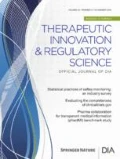Abstract
Guidelines/or conducting interim analyses in clinical trials sponsored by the pharmaceutical industry have been recently published (1). Usually, the clinical trial will terminate or the design will change when the interim analysis shows outstanding efficacy results. There are situations, however, where the interim analysis shows outstanding efficacy results and yet the study continues, for example, when regulatory requirements in the United States and Europe differ concerning study duration. A case study is presented which describes the statistical and operational issues encountered while performing a two-year interim analysis of a three-year registration study when the study was to continue to the three-year timepoint with the same design regardless of the outcome of the interim analysis. The statistician plays a central role in developing and implementing the strategy to effectively resolve these issues.
Similar content being viewed by others
References
PMA Biostatistics and Medical A. Hoc Committee on Interim Analysis. Interim analysis in the pharmaceutical industry. Control Clin Trials 1993;14:160–173.
Enas GG, Zerbe RL. A paradigm for interim analyses in controlled clinical trials. J Clin Res Drug Develop 1993;7:193–202.
Jennison C, Turnbull BW. Statistical approaches to interim monitoring of medical trials: A review and commentary. Stat Sci 1990;5(3):299–317.
Lee JW. Group sequential testing in clinical trials with multivariate observations: A review. Stat Med 1994;13:101–111.
Lee JW, DeMets DL. Group sequential comparison of changes: Ad hoc versus more exact method. Biometrics 1995;5:21–30.
O’Neill RT. Conclusions to early stopping rules workshop. Stat Med 1994;13:1493–1499.
ICH Harmonized Tripartite Guidance. Statistical Principles for Clinical Trials (E9). Recommended for Adoption at Step 4, 1998.
Freedman L, Anderson G, Kipnis V, Prentice R, Wang CY, Rossouw J, Wittes J, DeMets D. Approaches to monitoring the results of long-term disease prevention trials. Control Clin Trials 1996;17:509–525.
Author information
Authors and Affiliations
Rights and permissions
About this article
Cite this article
Huster, W., Shah, A., Kaiser, G. et al. Statistical and Operational Issues Arising in an Interim Analysis When the Study Will Continue. Ther Innov Regul Sci 33, 869–875 (1999). https://doi.org/10.1177/009286159903300328
Published:
Issue Date:
DOI: https://doi.org/10.1177/009286159903300328




